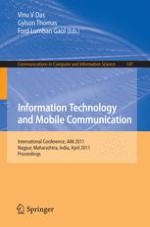2011 | Buch
Information Technology and Mobile Communication
International Conference, AIM 2011, Nagpur, Maharashtra, India, April 21-22, 2011. Proceedings
herausgegeben von: Vinu V Das, Gylson Thomas, Ford Lumban Gaol
Verlag: Springer Berlin Heidelberg
Buchreihe : Communications in Computer and Information Science
